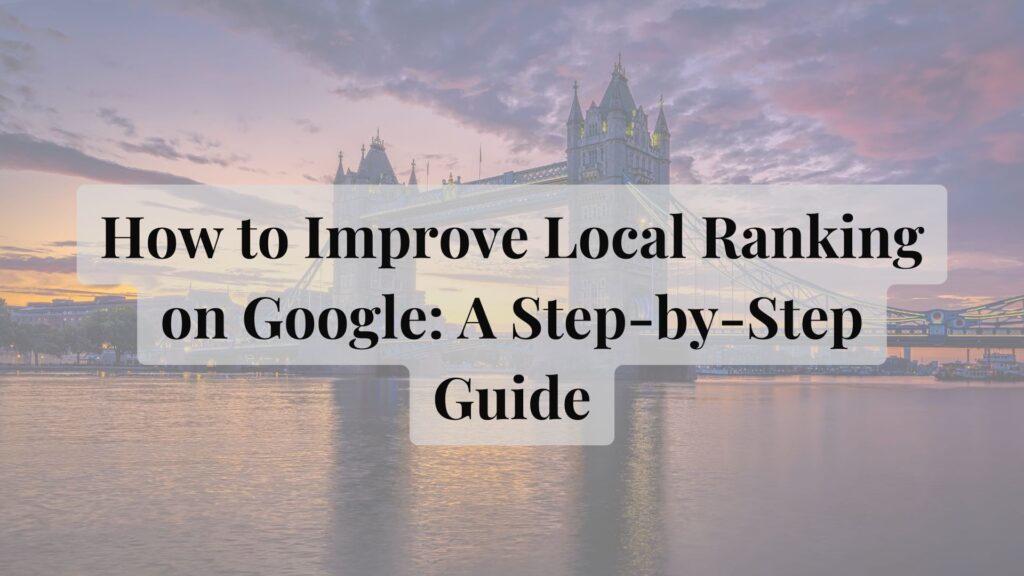
Local SEO is no longer an option—it’s the lifeline of businesses looking to attract customers in their area. Whether you run a small café, a law firm, or a multi-location business, your visibility on Google’s local search results can make or break your success. The competition is fierce, and Google’s algorithm is constantly evolving. So, how do you ensure that your business ranks higher than your competitors?
This guide breaks down the essentials of improving your local ranking on Google, step by step. No fluff—just real, actionable strategies that work.
List the steps to improve local rankings on Google
1. Optimize Your Google Business Profile (GBP)
Google Business Profile (formerly Google My Business) is the cornerstone of local SEO. If you haven’t claimed and optimized your GBP listing, you’re handing customers to your competitors on a silver platter.
How to do it right:
- Claim and verify your listing – Google won’t rank an unverified business profile.
- Ensure accuracy – Your business name, address, and phone number (NAP) should be consistent across the web.
- Choose the right categories – Be specific. If you own a sushi restaurant, don’t just pick “Restaurant”—select “Sushi Restaurant.”
- Write a compelling description – Use relevant keywords naturally but make it informative.
- Add high-quality photos – Businesses with quality images receive 42% more requests for directions.
- Keep your hours updated – Nothing frustrates customers more than incorrect business hours.
- Encourage and respond to reviews – More on this in the next section.
2. Get More (and Better) Customer Reviews
Google values trust, and nothing screams credibility like authentic customer reviews. Reviews directly impact local search rankings and customer decisions.
How to get more reviews:
- Ask your satisfied customers – Politely request reviews in person, via email, or through SMS.
- Make it easy – Provide a direct link to your Google review page.
- Respond to every review – Engage with customers. A simple “Thank you!” goes a long way.
- Address negative feedback professionally – Turn a bad experience into a positive resolution.
3. Ensure NAP Consistency Across All Platforms
Your business name, address, and phone number (NAP) should be uniform across Google, your website, and other online directories. Inconsistent details confuse search engines and can hurt your ranking.
How to maintain consistency:
- Use the exact same format on your website, GBP, social media, and business directories.
- List your business in top directories like Yelp, Bing Places, and Apple Maps.
- Monitor for discrepancies using tools like Moz Local or BrightLocal.
4. Optimize Your Website for Local SEO
A well-optimized website tells Google that your business is relevant to local searches.
Key optimizations:
- Include your city and state in title tags, meta descriptions, and headings.
- Create location-specific pages if you have multiple branches.
- Use schema markup to help search engines understand your content.
- Make your site mobile-friendly – Over 60% of local searches come from mobile devices.
5. Leverage Local Citations and Backlinks
Google values credibility, and backlinks from reputable sources reinforce your business’s authority.
How to build local links:
- Get listed in reputable business directories.
- Partner with local bloggers or news sites for features.
- Join local business associations that provide website links.
6. Create High-Quality, Locally Relevant Content
Content is king, but local content is the emperor. Creating locally relevant content establishes your business as an authority in your area.
Effective content ideas:
- Local guides (e.g., “Best Coffee Shops in New York City”)
- Neighborhood news and updates
- Case studies or success stories featuring local customers
7. Optimize for Voice Search
Voice search is on the rise, with 58% of consumers using it to find local businesses.
How to optimize:
- Use conversational keywords (e.g., “Where’s the best pizza near me?”).
- Create an FAQ page with common customer queries.
8. Utilize Social Media for Local Engagement
Social signals don’t directly impact rankings, but they increase visibility and engagement.
Best practices:
- Engage with your community by posting local news, events, and promotions.
- Encourage check-ins – Customers tagging your location boosts visibility.
9. Monitor Your Performance and Adapt
SEO is not a one-and-done strategy. You need to track, analyze, and tweak your approach.
Essential tools:
- Google Search Console – Tracks search performance.
- Google Analytics – Analyzes visitor behavior.
- Google Business Insights – Provides local search data.
Conclusion
Improving your local ranking on Google requires a strategic and consistent approach. From optimizing your Google Business Profile to leveraging customer reviews, every detail matters. Follow these steps diligently, and you’ll not only improve your rankings but also drive more traffic, leads, and sales to your business.
If you’re looking for affordable local SEO services, investing in professional assistance can accelerate your success. Get started today and dominate your local market.
FAQs:
1. How long does it take to see results from local SEO efforts?.
Local SEO improvements can start showing results within 4 to 12 weeks, depending on factors like competition, your website’s current status, and the strategies implemented. Consistency is key, so regular updates and engagement are essential.
2. Why is Google Business Profile important for local SEO?
Google Business Profile (GBP) is crucial because it allows your business to appear in local search results, Google Maps, and the Local Pack. An optimized GBP profile enhances your visibility, credibility, and chances of attracting local customers.
3. How do customer reviews impact local SEO rankings?
Customer reviews signal trust and authority to Google. Businesses with more positive reviews are more likely to rank higher in local search results. Responding to reviews also demonstrates engagement, further boosting your reputation.
4. What is NAP consistency, and why is it important?
NAP consistency refers to maintaining uniformity in your business name, address, and phone number across all online platforms. Inconsistent details confuse search engines and potential customers, negatively impacting your local SEO efforts.
5. How can voice search optimization improve my local SEO?
Voice search queries are often conversational and question-based. Optimizing your content with natural language, long-tail keywords, and an FAQ section improves your chances of ranking in voice search results, helping you capture local customers seeking immediate answers.






